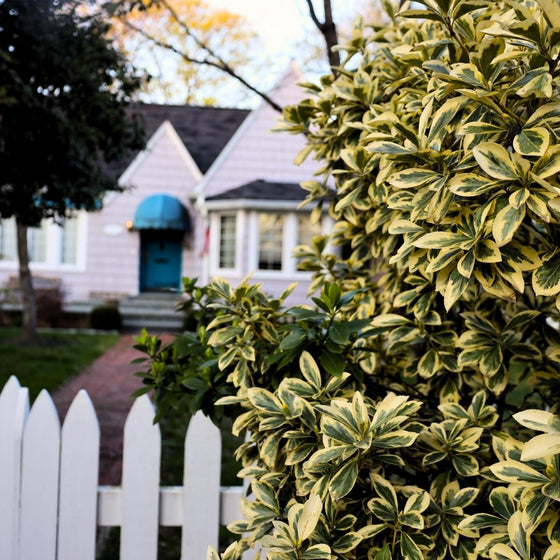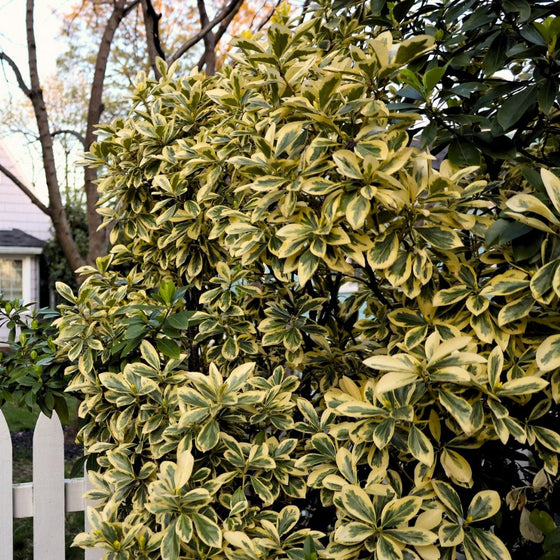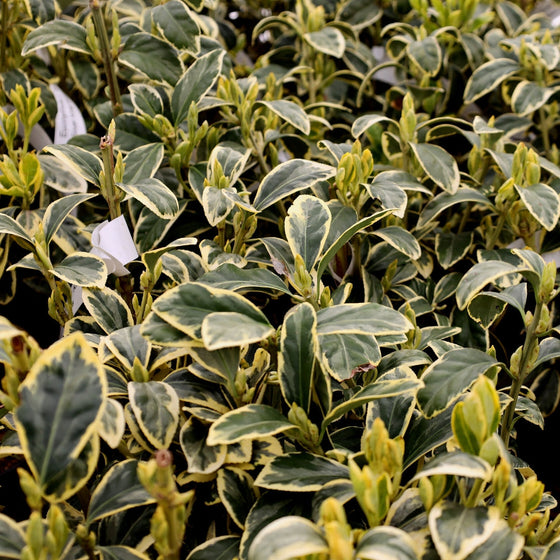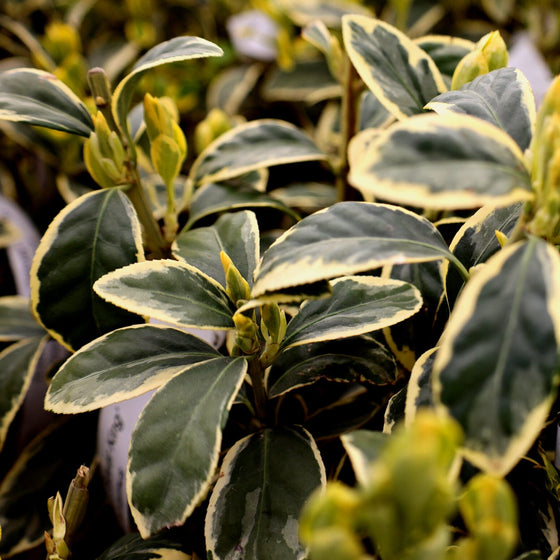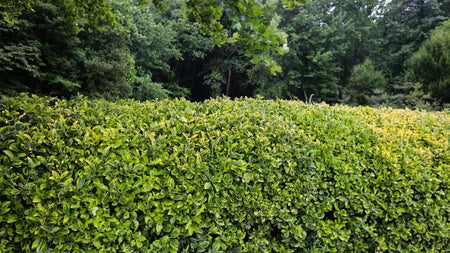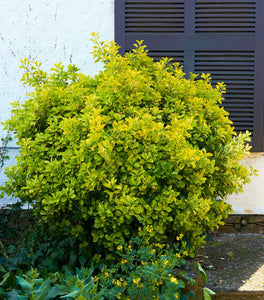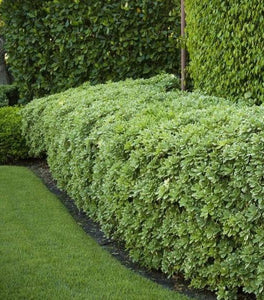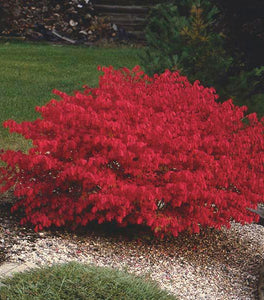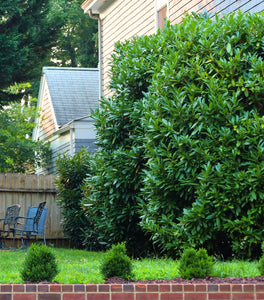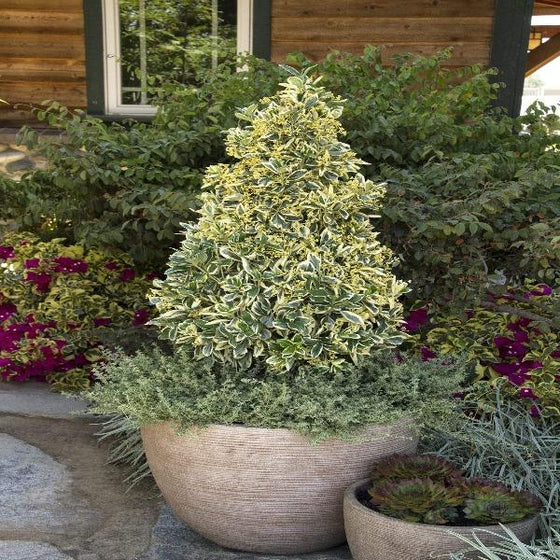
Images Depict Mature Plants
Silvery Variegation and Evergreen Charm for Every Landscape
Bright Foliage That Shines Year-Round
Euonymus japonicus ‘Silver King’ is a compact, evergreen shrub with distinctive variegated leaves — deep green centers framed by silvery-white margins. This refined color contrast adds instant brightness and definition to foundation plantings, mixed borders, and entryway gardens. With dense, upright growth and year-round foliage, Silver King delivers structure and sparkle through every season.
Compact Form with Multiple Landscape Uses
Growing 4–6 feet tall and 3–4 feet wide, Silver King Euonymus fits beautifully into formal hedges, mass plantings, or accent positions. Its tidy habit responds well to shearing and makes it a natural choice for low privacy screens or foundation lines. The upright branches retain their shape even in strong winds and salt spray, making this shrub a favorite for both coastal and urban gardens.
Drought, Heat, and Salt Tolerance
Silver King Euonymus is tough as it is beautiful. Once established, it tolerates heat, drought, and salt, thriving in sunny, well-drained locations. Its thick foliage resists deer and disease, allowing it to maintain its handsome look with minimal care. From front yards to commercial sites, this durable evergreen never fails to impress.
An Accent That Complements Everything
Pair Silver King with evergreen conifers for texture contrast or against dark backdrops to highlight its silvery edges. It balances brightly colored annuals and pairs well with boxwoods, holly, or lavender for a refined garden palette. Whether as a formal hedge or stand-alone specimen, it always delivers sophisticated color and structure.
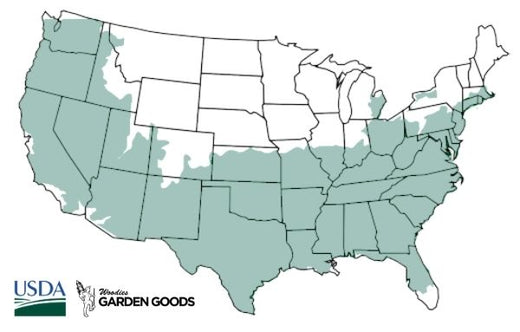
| Botanical Name | Euonymus japonicus ‘Silver King’ |
|---|---|
| Mature Height: | 4 to 6 feet |
| Mature Width: | 3 to 4 feet |
| Sunlight: | Full Sun to Partial Shade |
| Bloom Time / Color | Evergreen foliage; insignificant flowers |
| Foliage: | Glossy Green with silvery-white edges |
| Soil Condition: | Well-drained, average soil |
| Water Requirements: | Moderate; low once established |
| Resistance | Deer-resistant; salt- and drought-tolerant |
| Landscape Uses | Hedges, borders, foundation plantings, containers |
How to Care for Silver King Euonymus
Be sure to read our planting instructions to ensure a healthy and happy Silver King Euonymus for years to come!
How should I plant Silver King Euonymus?
Choose a sunny to partly shaded location with well-drained soil. Dig a hole twice as wide as the root ball and just as deep. Loosen the soil around the edges, set the plant so the top of the root ball is level with the ground, and backfill gently. Firm the soil and water deeply after planting. For hedges or borders, space plants 3 feet apart to allow them to fill in seamlessly. Apply a 2–3-inch layer of mulch around the base to retain moisture and moderate temperature, keeping mulch off the stems to prevent rot.
How often should I water Silver King Euonymus after planting?
Water deeply once or twice per week for the first month to help roots establish. After that, reduce watering to once every 7–10 days depending on weather conditions. Once established, Silver King is remarkably drought-tolerant and can go weeks without supplemental watering. During hot or dry spells, occasional deep watering helps keep foliage lush and vibrant.
When should I fertilize Silver King Euonymus?
Fertilize in early spring with a balanced, slow-release formula (10-10-10) to encourage healthy growth and dense foliage. If your soil is poor, a mid-summer feeding may boost color and vigor. Organic alternatives like compost or fish emulsion can also be used to support soil health. Avoid over-fertilizing, which can promote leggy growth.

When and how should I prune Silver King Euonymus?
Prune in late winter or early spring to shape and remove dead or crossing branches. This shrub responds well to light trimming and can be maintained as a formal hedge with occasional shearing. For a more natural look, skip annual shearing and allow the plant to develop its naturally rounded form. Avoid heavy pruning in summer, which can stress new growth in heat.

